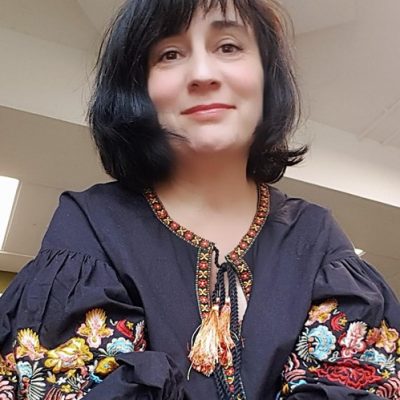The Global Culture Jam, a jam like no other
Dr Chrissi Nerantzi and Linda Matthews

Summary
The Global Culture Jam is a programme that aims to foster cross-cultural learning and teaching and bring together students and educators from different institutions nationally and internationally. It has been developed by educators and students from Manchester Metropolitan University and was offered for the first time in June 2021 as a five-day fully online active learning programme. The themes we explored were around community, sustainability, curriculum and creativity. Educators, students and guests worked together in partnership to create a stimulating, engaging and creative programme to celebrate diversity and bring participants closer together. The programme consisted of a series of live events and self-paced activities all supported and co-facilitated by educators and students. We had over 700 registrations from over 20 different countries. Guest speakers were from Italy, South Africa, Brazil, India, the US and the UK. There were over 1400 participations in the live events throughout the week. Eleven undergraduate, postgraduate and doctoral students worked in partnership with 18 educators and guests nationally and internationally, as co-leaders, co-designers and co-makers to put together a stimulating and highly interactive programme, including 17 live sessions that attracted from 51 to 208 participants per session. The feedback suggests that the Global Culture Jam was not only an enjoyable event but also highly impactful as it boosted academic confidence and helped develop and strengthen cross-cultural competencies and also create new professional relationships with educators which led to further collaborations.
This contribution will provide some insights into the Global Culture Jam programme and help others consider such an approach in their professional context with educators and students to foster cross-cultural active learning, development and partnership working.
What is the idea?
The Global Culture Jam (GCJ) is a programme designed to enable and foster cross-cultural learning and teaching and bring together students and educators from different institutions nationally and internationally. It is inspired by practices, pedagogical approaches and research linked to #creativeHE, an international community that was founded in 2015 and now has team members from 14 institutions in the UK, Greece and Canada and over 600 community members nationally and internationally (Nerantzi et al., 2018).
The GCJ ran in June 2021 as a five-day fully online active learning programme. It was a partner event to the Learning and Teaching Festival organised by Manchester Met’s University Teaching Academy, and was also integrated into an institutional scheme called RISE, which seeks to acknowledge and potentially credit students’ extracurricular activities. The GCJ was organised into four strands, namely community, sustainability, curriculum and creativity. These provided the thematic scaffold of the GCJ. The programme consisted of a series of live events and self-paced activities utilising participatory, active and collaborative learning approaches such as making, storytelling, learning with objects and play for example and created multiple opportunities over the 5 days to actively engage participants, facilitators and guests into a series of creative tasks and activities to stimulate sharing in a range of ways that brought individuals together through personal and joined-up explorations. The underpinning pedagogical orientations used in the GCJ can be traced back to active learning such as social constructivism (Vygotsky, 1962) and constructionism or learning through making (Gauntlett, 2011; Papert & Harel, 1991) as well as experiential learning (Dewey, 1938). This meant that more complex topics such as community, curriculum sustainability and creativity in the cross-cultural landscape could be explored in a varied, accessible and hands-on way that gave everybody a voice and varied opportunities to express, contribute and learn with and from each other. As the GCJ was offered fully online using digital networked technologies and social media the following design principles were applied 1. Activities, 2. Choice, 3. Facilitator support and 4. Community to boost interaction and engagement in these settings (Nerantzi, 2017).
The event was supported and co-facilitated by educators and students. Educators, students and guests worked together in partnership to create a stimulating, engaging and creative programme to celebrate diversity and bring participants closer together. We recruited undergraduate, postgraduate and doctoral students as co-creators in the form of makers and designers of learning activities and resources (Mercer-Mapstone et al., 2017). Students worked closely with the academic team for two months in advance of the event on co-designing the programme and specific strand activities. Overall, the team consisted of 30 team members. Educators, students from across the institution, interns and further support staff from the International Mobility Office.
MSTeams platform was used to build and facilitate the event globally. We had over 700 registrations from over 20 different countries. Our guest speakers were from Italy, South Africa, Brazil, India, the US and the UK. As large number of participants were anticipated, Zoom was used for all the live participatory sessions. These were spread across the day to attract as many participants as possible from different time zones and recordings were made available immediately after the live sessions. There was a live session for each strand from Monday to Thursday and a final celebratory event on Friday that brought the event to a close. There were over 1,400 participations in the 17 live events throughout the week. The live sessions were complemented with self-paced activities for each strand, creating flexible engagement opportunities anytime, anywhere, facilitated by educators and students. The Café and Helpline discussions provided additional spaces to socialise and seek support if needed. Facilitators had their own discussion channel to support each other and troubleshoot during the event. Padlets were used throughout the week as well as some Google Drive tools to share, collaborate and curate creations and artefacts during the week linked to the different strand activities. The Doodlefan tool enabled participants to create their own picture book scenes linked to an open education activity. The GCJ had specialist input from museum curators and specialists. This led to the creation of a GCJ museum to curate and showcase some of the work generated by participants during the week. Furthermore the #GCJam21 hashtag was used on social media, such as Twitter and Instagram to extend opportunities for engagement.
Why this idea?
As the pandemic brought about radical changes to how higher education institutions operated, and campus-based provision rapidly moved online (Bozkurt et al., 2020), global travel restrictions and social distancing became the norm, the GCJ was from the outset designed to be a fully online programme in the form of virtual student and staff mobility using digital networked technologies and active collaborative and creative learning and teaching approaches, creating an innovative and resourceful solution and an oasis of hope and togetherness during very challenging times to enrich the institutional internationalisation offer and provide stimulating learning opportunities to engage our students and educators institutionally, nationally and internationally.
The GCJ was developed by a team of educators and students from diverse disciplinary areas, backgrounds and orientations from across Manchester Met during the academic year 2020/21. A partnership model of working was adopted from the beginning to maximise on individual diverse expertise, develop new skills and competencies within the team and work together creatively towards making the GCJ a success. The educators were all members of the RISE Internationalisation workstream, who supported the idea of the GCJ and invested in it. Internationalisation is a strategic institutional priority and there was consensus that the GCJ idea would support and strengthen institution-wide activities in this area during very challenging times.
Educators and students partnership working within the host institution has been beneficial for both. Such practices could be considered also in formal curriculum design activities. The feedback suggests that the GCJ was not only an enjoyable event for the team itself, educators and students but also for participants. Furthermore, it seems that the GCJ has been highly impactful as it boosted confidence and helped develop and strengthen cross-cultural competencies and help individuals to connect with others in different parts of the world, build relationships and feel part of a vibrant and diverse global learning community during a very challenging period worldwide. The institution is currently considering adapting this approach for an International Summer School.
How could others implement this idea?
The GCJ may present an attractive intervention for other institutions who are considering developing virtual student mobility or remote summer school offers that create active and immersive learning opportunities. Post-pandemic, a blended approach could also be considered to offer such a programme and strengthen relationships with collaborative partner institutions.
Further developing the partnership model and extending this to collaborative partner institutions would further diversify and refresh the offer annually, creating multiple opportunities for educators and students to develop and collaborate.
The GCJ can be adapted to suit the context of different institutions, wanting to enrich curricula by creating opportunities for students to co-construct an international study event. Integrating students into the project management team ensures the programme reflects the student perspectives, as well as providing valuable professional and leadership learning opportunities to enhance their employability.
If you are implementing a GCJ event, consider working through the following stages-
· Select the team, time allocations
· Define clear roles and responsibilities, communication, buddy system
· Define purpose and theme(s), needs, priorities, aspirations
· Timeline, milestones and timing, maximising engagement
· Agree partnership approach from the outset, educators, and students from the beginning, consider a cross-institutional approach with a partner from another part of the world.
· Design the active learning programme and build in socialisation
· Create a simple structure (see below under useful resource). Avoid too many and too long live sessions. Allow reflective space in between.
· Select simple digital tools and platforms, remember less is more and be aware that not all are available in every part of the world
Links to tools and resources
An openly licensed Jam Jar is available. It was an Open Education for a Better World project led by Sara Merkaj aiming to create a blueprint based on the GCJ which could be adapted by educators and students. You can access the resource here.
References
Bozkurt, A., Jung, I., Xiao, J., Vladimirschi, V., Schuwer, R., Egorov, G., Lambert, S. R., Al-Freih, M., Pete, J., Olcott, Jr. D., Rodes, V., Aranciaga, I., Bali, M., Alvarez, Jr. A. V., Roberts, J., Pazurek, A., Raffaghelli, J. E., Panagiotou, N., de Coëtlogon, P. …Paskevicius, M. (2020). A global outlook to the interruption of education due to COVID-19 pandemic: Navigating in a time of uncertainty and crisis. Asian Journal of Distance Education, 15(1), 1–126. http://doi.org/10.5281/zenodo.3878572
Dewey, J. (1938) Experience and education. Macmillan.
Gauntlett, D. (2011) Making is connecting. The social meaning of creativity, from DIY and knitting to YouTube and Web 2.0., Cambridge: Polity Press
Mercer-Mapstone, L., Dvorakova, S. L., Matthews, K. E., Abbot, S., Cheng, B., Felten, P., Knorr, K., Marquis, E., Shammas, R. & Swaim, K. (2017). A systematic literature review of students as partners in higher education. International Journal for Students as Partners, 1(1), 1-23. https://doi.org/10.15173/ijsap.v1i1.3119
Nerantzi, C. (2017). Towards a framework for cross-boundary collaborative open learning in cross-institutional academic development [PhD thesis, Edinburgh Napier University].
Nerantzi, C., Jackson, N. J., Mouratoglou, N., & Baff, D. (2018). Learning and teaching partnership narratives relating to the open course Creativity for Learning in Higher Education (#creativeHE). Compass: Journal of Learning and Teaching, 11(2), 1-11. http://dx.doi.org/10.21100/compass.v11i2.794
Papert, S., & Harel, I. (1991). Situating Constructionism. Constructionism. Ablex Publishing. http://www.papert.org/articles/SituatingConstructionism.html
Vygotsky, L.S. (1962). Thought and language. MIT Press. (Original work published 1934).
Image Attribution
Global Culture Jam Banner by Ben Davies (using the GCJ logo designed by Sara Merkaj) is used under a CC-BY-NC 4.0 Licence.



